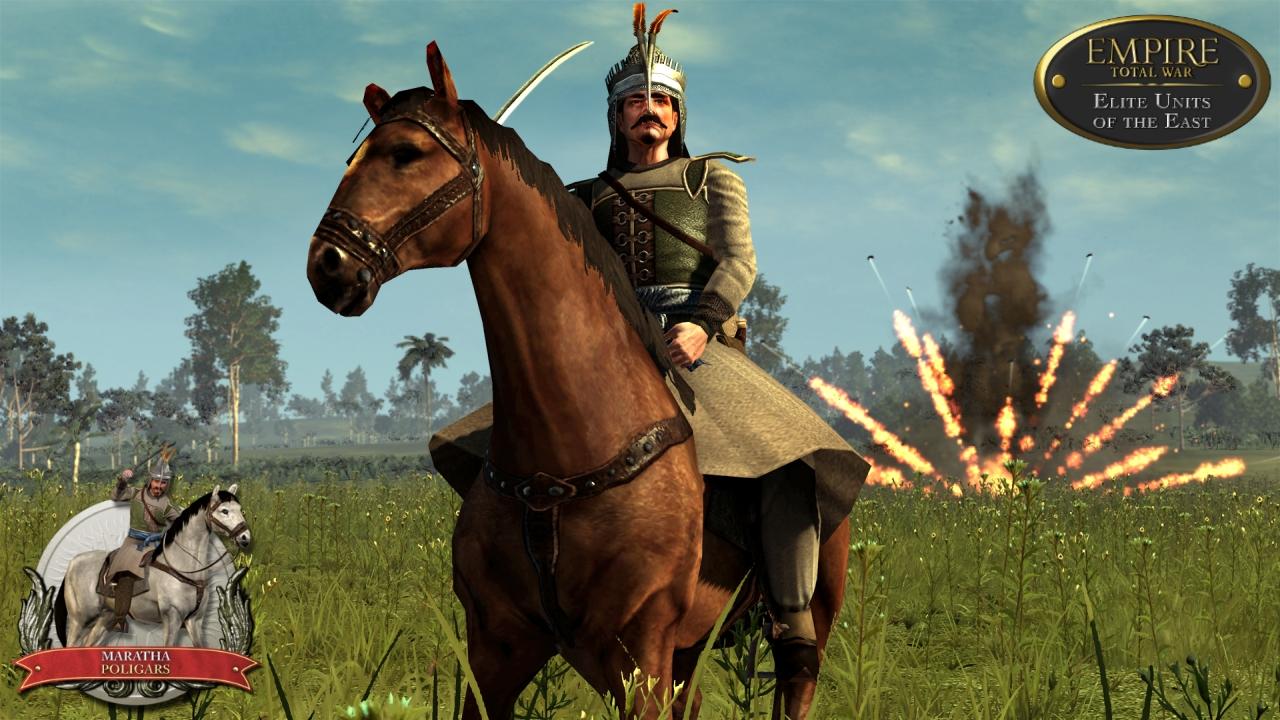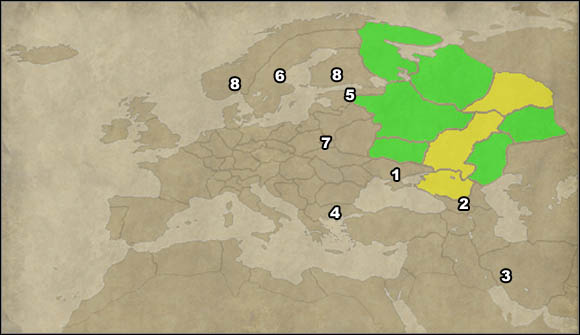Empire: Total War PC walkthrough and guide at GameSpy - Check out the latest walkthroughs and guides for PC. Ottoman Empire Campaign Walkthrough: 09.
- Could The Ottoman Empire Avoid WWI? - Quora
- Ottoman Empire Grand Campaign Guide - Steam Community
- Empire Total War Campaign Guide
- Empire Total War Ottoman Empire Guide Build
- The history of Europe over the last centuries can be seen as the history of the Ottoman Empire and a few annoying, small nations that thwarted Ottoman ambitions. Ottoman power is unmatched in its extent and grandeur, straddling the traditional trade route between Europe and Asia. The Creative Assembly and the Total War logo are trademarks.
- In order to get the required 40 provinces, you can continue to fight the Ottoman Empire. Then take Georgia, Persia, and Russia (only if you find that it is a militarily weak country). All provinces near the Caspian Sea should fall into your hands.
- Ottoman Empire is in a very bad condition. Moreover you have many enemies - Russia, Georgia, Persia, Morocco and Venice - these are your potentials opponents. In addition you will have some religious disturbances. At the beginning try to develop your technology and infrastructure.
- The Ottoman state to 1481: the age of expansion
- Origins and expansion of the Ottoman state, c. 1300–1402
- Restoration of the Ottoman Empire, 1402–81
- Ottoman institutions in the 14th and 15th centuries
- The peak of Ottoman power, 1481–1566
- Domination of southeastern Europe and the Middle East
- The decline of the Ottoman Empire, 1566–1807
- Internal problems
- Imperial decline in the 18th and early 19th centuries
- The empire from 1807 to 1920
- Rule of Mahmud II
- The Tanzimat reforms (1839–76)
- Rule of Abdülhamid II
- Dissolution of the empire
Our editors will review what you've submitted and determine whether to revise the article.
Could The Ottoman Empire Avoid WWI? - Quora

Ottoman Empire Grand Campaign Guide - Steam Community


Ottoman Empire, empire created by Turkish tribes in Anatolia (Asia Minor) that grew to be one of the most powerful states in the world during the 15th and 16th centuries. The Ottoman period spanned more than 600 years and came to an end only in 1922, when it was replaced by the Turkish Republic and various successor states in southeastern Europe and the Middle East. At its height the empireencompassed most of southeastern Europe to the gates of Vienna, including present-day Hungary, the Balkan region, Greece, and parts of Ukraine; portions of the Middle East now occupied by Iraq, Syria, Israel, and Egypt; North Africa as far west as Algeria; and large parts of the Arabian Peninsula. The term Ottoman is a dynastic appellation derived from Osman I (Arabic: ʿUthmān), the nomadic Turkmen chief who founded both the dynasty and the empire about 1300.
Where did the Ottoman Empire start?
The Ottoman Empire was founded in Anatolia, the location of modern-day Turkey. Originating in Söğüt (near Bursa, Turkey), the Ottoman dynasty expanded its reign early on through extensive raiding. This was enabled by the decline of the Seljuq dynasty, the previous rulers of Anatolia, who were suffering defeat from Mongol invasion.
How did the Ottoman Empire start?
Empire Total War Campaign Guide
The Ottoman Empire began at the very end of the 13th century with a series of raids from Turkic warriors (known as ghazis) led by Osman I, a prince (bey) whose father, Ertugrul, had established a power base in Söğüt (near Bursa, Turkey). Osman and his warriors took advantage of a declining Seljuq dynasty, which had been severely weakened by the Mongol invasions. The Ottoman dynasty continued to expand for several generations, controlling much of southeastern Europe, the Middle East, and North Africa at its peak. Osman's grandson Murad I laid the foundation for an institutionalized Ottoman state, continued by Murad's son Bayezid I.
Why was the Ottoman Empire called 'the sick man of Europe'?
After the peak of Ottoman rule under Süleyman the Magnificent in the 16th century, the Ottoman Empire struggled to maintain its bloated bureaucracy and decentralized political structure. Mxl usb mic mate dynamic xlr to usb microphone adapter for macbook. Several attempts at reform kept the empire afloat but mostly addressed immediate issues, and any success was short-lived. The most far-reaching of these reforms, the Tanzimat, contributed to a debt crisis in the 1870s. Its fragile state left it unable to withstand defeat in World War I, and most of its territories were divided as spoils as the empire disintegrated.
How did the Ottoman Empire end?
Power rangers pc game download. The Ottoman Empire disintegrated and was partitioned after its defeat in World War I. The empire had already been in decline for centuries, struggling to maintain a bloated bureaucracy or a centralized administrative structure after various attempts at reform. The problem was exacerbated further by the rise of more localized interests across the empire, such as the rise of nationalist movements. Upon the Ottomans' defeat in World War I, a combination of nationalist movements and partition agreements among the Allied powers forced its disintegration into numerous territories, with Turkey as the empire's immediate successor.
The Ottoman state to 1481: the age of expansion
The first period of Ottoman history was characterized by almost continuous territorial expansion, during which Ottoman dominion spread out from a small northwestern Anatolian principality to cover most of southeastern Europe and Anatolia. The political, economic, and social institutions of the classical Islamic empires were amalgamated with those inherited from Byzantium and the great Turkish empires of Central Asia and were reestablished in new forms that were to characterize the area into modern times.
Origins and expansion of the Ottoman state, c. 1300–1402
In their initial stages of expansion, the Ottomans were leaders of the Turkish warriors for the faith of Islam, known by the honorific title ghāzī (Arabic: 'raider'), who fought against the shrinking Christian Byzantine state. The ancestors of Osman I, the founder of the dynasty, were members of the Kayı tribe who had entered Anatolia along with a mass of Turkmen Oğuz nomads. Those nomads, migrating from Central Asia, established themselves as the Seljuq dynasty in Iran and Mesopotamia in the mid-11th century, overwhelmed Byzantium after the Battle of Manzikert (1071), and occupied eastern and central Anatolia during the 12th century. The ghazis fought against the Byzantines and then the Mongols, who invaded Anatolia following the establishment of the Il-Khanid (Ilhanid) empire in Iran and Mesopotamia in the last half of the 13th century. With the disintegration of Seljuq power and its replacement by Mongol suzerainty, enforced by direct military occupation of much of eastern Anatolia, independent Turkmen principalities—one of which was led by Osman—emerged in the remainder of Anatolia.
- c. 1300 - 1922
Empire Total War Ottoman Empire Guide Build
- key people
- major events
- related places
- related topics

Ottoman Empire Grand Campaign Guide - Steam Community
Britannica's Publishing Partner Program and our community of experts to gain a global audience for your work!Ottoman Empire, empire created by Turkish tribes in Anatolia (Asia Minor) that grew to be one of the most powerful states in the world during the 15th and 16th centuries. The Ottoman period spanned more than 600 years and came to an end only in 1922, when it was replaced by the Turkish Republic and various successor states in southeastern Europe and the Middle East. At its height the empireencompassed most of southeastern Europe to the gates of Vienna, including present-day Hungary, the Balkan region, Greece, and parts of Ukraine; portions of the Middle East now occupied by Iraq, Syria, Israel, and Egypt; North Africa as far west as Algeria; and large parts of the Arabian Peninsula. The term Ottoman is a dynastic appellation derived from Osman I (Arabic: ʿUthmān), the nomadic Turkmen chief who founded both the dynasty and the empire about 1300.
Where did the Ottoman Empire start?
The Ottoman Empire was founded in Anatolia, the location of modern-day Turkey. Originating in Söğüt (near Bursa, Turkey), the Ottoman dynasty expanded its reign early on through extensive raiding. This was enabled by the decline of the Seljuq dynasty, the previous rulers of Anatolia, who were suffering defeat from Mongol invasion.
How did the Ottoman Empire start?
Empire Total War Campaign Guide
The Ottoman Empire began at the very end of the 13th century with a series of raids from Turkic warriors (known as ghazis) led by Osman I, a prince (bey) whose father, Ertugrul, had established a power base in Söğüt (near Bursa, Turkey). Osman and his warriors took advantage of a declining Seljuq dynasty, which had been severely weakened by the Mongol invasions. The Ottoman dynasty continued to expand for several generations, controlling much of southeastern Europe, the Middle East, and North Africa at its peak. Osman's grandson Murad I laid the foundation for an institutionalized Ottoman state, continued by Murad's son Bayezid I.
Why was the Ottoman Empire called 'the sick man of Europe'?
After the peak of Ottoman rule under Süleyman the Magnificent in the 16th century, the Ottoman Empire struggled to maintain its bloated bureaucracy and decentralized political structure. Mxl usb mic mate dynamic xlr to usb microphone adapter for macbook. Several attempts at reform kept the empire afloat but mostly addressed immediate issues, and any success was short-lived. The most far-reaching of these reforms, the Tanzimat, contributed to a debt crisis in the 1870s. Its fragile state left it unable to withstand defeat in World War I, and most of its territories were divided as spoils as the empire disintegrated.
How did the Ottoman Empire end?
Power rangers pc game download. The Ottoman Empire disintegrated and was partitioned after its defeat in World War I. The empire had already been in decline for centuries, struggling to maintain a bloated bureaucracy or a centralized administrative structure after various attempts at reform. The problem was exacerbated further by the rise of more localized interests across the empire, such as the rise of nationalist movements. Upon the Ottomans' defeat in World War I, a combination of nationalist movements and partition agreements among the Allied powers forced its disintegration into numerous territories, with Turkey as the empire's immediate successor.
The Ottoman state to 1481: the age of expansion
The first period of Ottoman history was characterized by almost continuous territorial expansion, during which Ottoman dominion spread out from a small northwestern Anatolian principality to cover most of southeastern Europe and Anatolia. The political, economic, and social institutions of the classical Islamic empires were amalgamated with those inherited from Byzantium and the great Turkish empires of Central Asia and were reestablished in new forms that were to characterize the area into modern times.
Origins and expansion of the Ottoman state, c. 1300–1402
In their initial stages of expansion, the Ottomans were leaders of the Turkish warriors for the faith of Islam, known by the honorific title ghāzī (Arabic: 'raider'), who fought against the shrinking Christian Byzantine state. The ancestors of Osman I, the founder of the dynasty, were members of the Kayı tribe who had entered Anatolia along with a mass of Turkmen Oğuz nomads. Those nomads, migrating from Central Asia, established themselves as the Seljuq dynasty in Iran and Mesopotamia in the mid-11th century, overwhelmed Byzantium after the Battle of Manzikert (1071), and occupied eastern and central Anatolia during the 12th century. The ghazis fought against the Byzantines and then the Mongols, who invaded Anatolia following the establishment of the Il-Khanid (Ilhanid) empire in Iran and Mesopotamia in the last half of the 13th century. With the disintegration of Seljuq power and its replacement by Mongol suzerainty, enforced by direct military occupation of much of eastern Anatolia, independent Turkmen principalities—one of which was led by Osman—emerged in the remainder of Anatolia.
- c. 1300 - 1922
Empire Total War Ottoman Empire Guide Build
- key people
- major events
- related places
- related topics
- Ottomans invented currently used surgical instruments such as forceps, scalpels, and catheters.
- The capture of Constantinople by the Ottomans caused many scholars to flee to Italy and bring with them knowledge that helped spark the Renaissance.
- Europeans have given Suleiman the moniker 'The Magnificent', but he was called 'The Lawgiver' by his own subjects.
